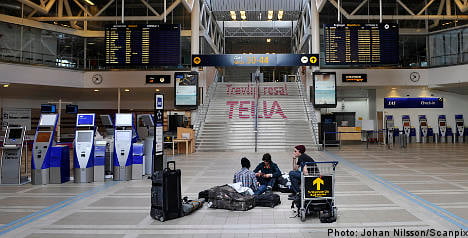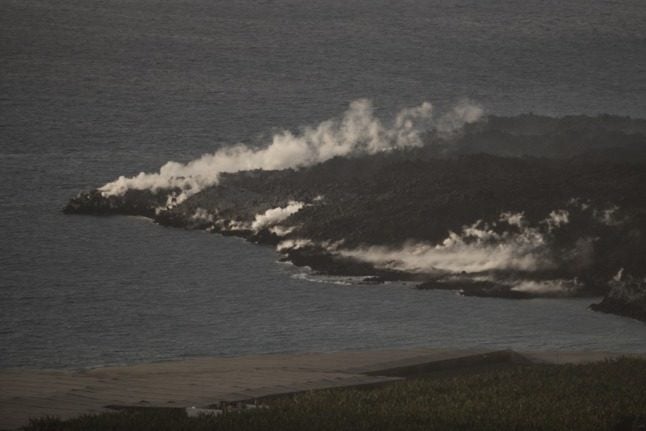The Swedish Aviation Authority (LFV) said flights could be grounded for the rest of the weekend.
“We’re not seeing any improvements based on the forecasts we currently have at our disposal. We’ll get the next forecast on Saturday morning and will make a new decision then,” said LFV press spokesman Björn Stenberg.
Sweden started to gradually open up airspace in its sparsely populated north at 8am, but authorities eventually closed some of the area up again, citing renewed ash cloud risks.
“We have this cloud with volcano ash coming in again from the Norwegian side. From 7pm [on Friday] we have to close part of (the area that was open) due to contamination,” Karl Selling of LFV told AFP.
“At 9pm [on Friday], the only thing that will be open will be the very far north” of Sweden, he added.
Meteorologists explained that high altitude winds tend to blow in a westerly direction, pushing the cloud of volcanic ash from Iceland right over Sweden.
“The location of the volcano is somewhat unfortunate from our perspective,” said Elin Torstensson at meteoroligal agency SMHI.
Norway and Sweden temporarily reopened some airspace on Friday, while Denmark and Finland said they were grounding all traffic until Saturday at least due to a cloud of volcanic ash from Iceland.
Along with Britain, Scandinavia was the region most affected by the colossal ash cloud slowly spreading over half of Europe and forcing the continent’s biggest air travel shutdown since World War II.
In Finland, an important hub between Europe and Asia, all flights were grounded late on Thursday and airport authorities said traffic could remain restricted for many days, which is how long meteorologists have forecast the cloud will hover over the Nordic country.
The Finnish airforce said pn Friday several F-18 Hornet jets that had flown only short flights over Finland on Thursday while the airspace remained open had seen “significant damage” to their engines from the volcanic ash.
Norway, Sweden, Denmark and Finland all completely closed their airspaces on Thursday, gradually shutting zones as the ash cloud approached.
Grounded passengers stormed buses and trains in the region, with Sweden’s long-distance bus company Swebus saying its traffic had tripled.
National rail companies across the region added trains, while taxis saw business boom, with numerous fares between the Nordic capitals.
Oslo Taxi reported that its longest trip so far had been a 1,800-kilometre drive from Oslo to Paris, while Monty Python comedy legend John Cleese took a $5,100 ride from the Norwegian capital to Brussels.
Scandinavian airline SAS cancelled 742 flights on Friday, grounding all but a few flights in the north of Norway as services restarted at a very slow pace.
Norway, the first European country to begin shutting down its airspace late Wednesday, started to allow flights from 9am in its northern half on Friday, for a limited time window.
“The decision (to open part of the airspace) was made on the basis of the latest meteorological data,” airport authority Avinor said in a statement.
“Ambulance flights will be given priority, and some passenger flights. In other words, (the airspace will) not open to normal flow of traffic,” it added.
Kastrup airport in Copenhagen, the region’s most important hub, was devoid of traffic on Friday as Denmark said it would not open its airspace before 2pm on Saturday at the earliest.
Authorities announced earlier on Friday first that airspace would open at 2am, before postponing the deadline after examining new meteorological data.
“As long as there is still ash in Danish skies we will not take any risk and will keep our airspace closed,” Jan Eliassen, a spokesman for air traffic control authority Naviair told AFP.
Ironically, airports remained open in Iceland due to favourable wind conditions, an airport authority spokeswoman told AFP, but flew flights could leave the island because the airspace was closed at most destinations.
“The wind is still taking the ash east to Europe,” Hjordis Gudmundsdottir said.
Iceland’s second volcanic eruption in less than a month began under the Eyjafjallajökull glacier in the south of the country on Wednesday.



 Please whitelist us to continue reading.
Please whitelist us to continue reading.
Member comments